Epson EB-1470UI User Manual
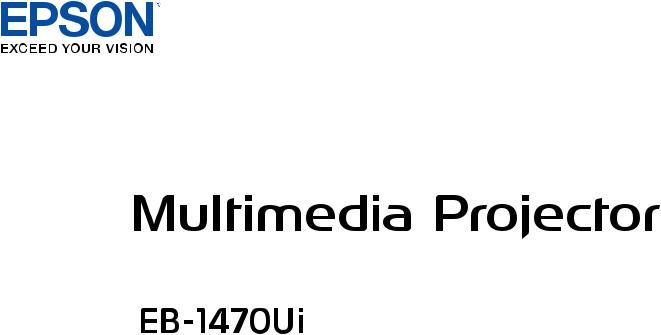
User's Guide

Contents |
|
Notations Used in This Guide |
8 |
Introduction to Your Projector |
9 |
Projector Features............................................................................ |
10 |
Long-life Laser Light Source...................................................................................................... |
10 |
Unique Interactive Functions.................................................................................................... |
10 |
Quick and Easy Setup .................................................................................................................. |
11 |
Flexible Connectivity.................................................................................................................... |
11 |
Connect with Computers ..................................................................................................... |
11 |
Connect with Mobile Devices............................................................................................. |
12 |
Easy Operation from the Control Pad ................................................................................... |
12 |
Large-scale Presentation from the Whiteboard ................................................................ |
13 |
Projector Parts and Functions ........................................................ |
14 |
Projector Parts - Front/Side ....................................................................................................... |
14 |
Projector Parts - Top/Side .......................................................................................................... |
15 |
Projector Parts - Interface........................................................................................................... |
16 |
Projector Parts - Base ................................................................................................................... |
18 |
Projector Parts - Control Panel................................................................................................. |
19 |
Projector Parts - Remote Control ............................................................................................ |
20 |
Projector Parts - Interactive Pens ............................................................................................ |
21 |
Projector Parts - Pen Stand........................................................................................................ |
22 |
Projector Parts - Control Pad..................................................................................................... |
23 |
Projector Parts - Touch Unit ...................................................................................................... |
24 |
Setting Up the Projector |
26 |
Projector Placement ........................................................................ |
27 |
Projector Setup and Installation Options............................................................................. |
27 |
Settings when Using the Interactive Features ................................................................... |
28 |
Settings when Using the Touch Unit............................................................................... |
29 |
|
2 |
Connecting to a Computer........................................................................................................ |
30 |
Connecting to a Computer for VGA Video and Audio .............................................. |
30 |
Connecting to a Computer for USB Video and Audio............................................... |
31 |
Connecting to a Computer for HDMI Video and Audio ........................................... |
32 |
Connecting a Computer to the Control Pad................................................................. |
33 |
Connecting to Smartphones or Tablets................................................................................ |
33 |
Connecting to Video Sources ................................................................................................... |
34 |
Connecting to an HDMI Video Source ............................................................................ |
35 |
Connecting to a Component-to-VGA Video Source .................................................. |
35 |
Connecting to a Composite Video Source..................................................................... |
36 |
Connecting to External USB Devices ..................................................................................... |
37 |
USB Device Projection ........................................................................................................... |
37 |
Connecting to a USB Device ............................................................................................... |
37 |
Connecting a USB Flash Drive to the Control Pad...................................................... |
38 |
Disconnecting a USB Device ............................................................................................... |
38 |
Connecting a Printer to the Control Pad.............................................................................. |
39 |
Connecting to a Document Camera ...................................................................................... |
39 |
Connecting an External USB Keyboard to the Control Pad .......................................... |
39 |
Connecting to External Output Devices............................................................................... |
40 |
Connecting to an External DVI Monitor.......................................................................... |
40 |
Connecting to a VGA Monitor ............................................................................................ |
41 |
Connecting to External Speakers ...................................................................................... |
42 |
Connecting Multiple Projectors of the Same Model ....................................................... |
42 |
Installing Batteries in the Remote Control.................................... |
45 |
Installing Batteries in the Pens....................................................... |
46 |
Remote Control Operation.............................................................. |
47 |
Using Basic Projector Features |
48 |
Turning On the Projector ................................................................ |
49 |
Home Screen................................................................................................................................... |
50 |
Projector Connections |
30 |
Turning Off the Projector ................................................................ |
52 |
|
|

Contents |
|
Setting the Date and Time .............................................................. |
53 |
Selecting the Language for the Projector Menus ......................... |
55 |
Focusing the Image.......................................................................... |
56 |
Image Shape..................................................................................... |
59 |
Correcting the Image Shape with the Keystone Buttons .............................................. |
59 |
Correcting the Image Shape with Quick Corner ............................................................... |
60 |
Correcting Image Shape with Curved Surface................................................................... |
62 |
Loading Image Shape Setting from Memory ............................................................... |
64 |
Resizing the Image with the Buttons ............................................. |
66 |
Adjusting the Image Position ......................................................... |
67 |
Selecting an Image Source.............................................................. |
68 |
Image Aspect Ratio .......................................................................... |
70 |
Changing the Image Aspect Ratio.......................................................................................... |
70 |
Available Image Aspect Ratios ................................................................................................. |
70 |
Projected Image Appearance with Each Aspect Mode .................................................. |
71 |
Color Mode ....................................................................................... |
72 |
Changing the Color Mode ......................................................................................................... |
72 |
Available Color Modes................................................................................................................. |
72 |
Turning On Automatic Luminance Adjustment................................................................ |
72 |
Adjusting the Image Color .............................................................. |
74 |
Adjusting the Hue, Saturation, and Brightness.................................................................. |
74 |
Adjusting the Gamma ................................................................................................................. |
75 |
Adjusting the Brightness................................................................. |
77 |
Constant Brightness Usage Hours .......................................................................................... |
78 |
Light Source Life Span................................................................................................................. |
79 |
Controlling the Volume with the Volume Buttons ....................... |
80 |
Using the Interactive Features |
81 |
|
3 |
Preparing Before Using Interactive Features................................ |
83 |
Safety Instructions for Interactive Features......................................................................... |
83 |
Using the Interactive Pens ......................................................................................................... |
83 |
Pen Calibration ......................................................................................................................... |
85 |
Calibrating Automatically..................................................................................................... |
85 |
Calibrating Manually .............................................................................................................. |
86 |
Using Interactive Touch Operations with Your Finger ................................................... |
88 |
Calibrating for Touch Operations with Your Finger................................................... |
90 |
Safety Instructions for Interactive Touch Operations................................................ |
92 |
Whiteboard Screens (Whiteboard Mode) ...................................... |
93 |
Starting Whiteboard Mode........................................................................................................ |
93 |
Safety Instructions for Whiteboard Mode...................................................................... |
94 |
Whiteboard Mode Toolbar ........................................................................................................ |
94 |
Whiteboard Mode Bottom Toolbar ........................................................................................ |
97 |
Projecting Scanned Images in Whiteboard Mode............................................................ |
99 |
Compatible File Types for Opening in Whiteboard Mode.......................................... |
100 |
Sharing Drawings Created in Whiteboard Mode............................................................ |
101 |
Saving Drawing Contents in Whiteboard Mode ....................................................... |
101 |
Available File Format in Whiteboard Mode ................................................................ |
103 |
Printing Drawing Contents in Whiteboard Mode..................................................... |
103 |
Available Printer Control Commands in Whiteboard Mode................................. |
104 |
Sending Emails in Whiteboard Mode............................................................................ |
104 |
Creating an Address Book ................................................................................................. |
106 |
Available Directory Service in Whiteboard Mode..................................................... |
106 |
Whiteboard Sharing with Other Devices........................................................................... |
107 |
Sharing Whiteboard Screen with Other Devices ...................................................... |
107 |
Connection to the Shared Whiteboard ........................................................................ |
110 |
Connecting to a Shared Whiteboard from a Projector........................................... |
110 |
Available Features when Connecting to a Whiteboard Screen .......................... |
111 |
Connecting to a Shared Whiteboard from a Computer or Other Device via |
|
a Web Browser ....................................................................................................................... |
113 |
Supported Web Browsers for Sharing a Whiteboard.............................................. |
114 |
Toolbar for Whiteboard Screen Connecting via a Web Browser ........................ |
114 |
Interactive Feature Modes .............................................................. |
82 |
Draw on the Projected Image Using Annotation Mode............. |
117 |

Contents |
|
Starting Annotation Mode ...................................................................................................... |
117 |
Annotation Mode Toolbar....................................................................................................... |
118 |
Annotation Mode Bottom Toolbar....................................................................................... |
119 |
Using Drawing Contents of Annotation Mode................................................................ |
120 |
Saving Drawing Contents in Annotation Mode ........................................................ |
120 |
Printing Drawing Contents in Annotation Mode...................................................... |
120 |
Control Computer Features from a Projected Screen |
|
(Computer Interactive Mode) ....................................................... |
122 |
Computer Interactive Mode System Requirements ...................................................... |
122 |
Using Computer Interactive Mode....................................................................................... |
123 |
Adjusting the Pen Operation Area....................................................................................... |
125 |
Installing Easy Interactive Driver on Mac........................................................................... |
126 |
Switching the Interactive Mode ................................................... |
127 |
Selecting Network Device Display ............................................... |
128 |
Connecting to a Remote Computer ............................................. |
130 |
Remote Desktop Connection System Requirements.................................................... |
131 |
Remote Desktop Connection Restrictions ........................................................................ |
132 |
Using the Interactive Features over a Network.......................... |
133 |
Precautions when Connecting to a Projector on a Different Subnet ..................... |
133 |
Windows Pen Input and Ink Tools ............................................... |
134 |
Enabling Windows Pen Input and Ink Features .............................................................. |
134 |
Using Windows Pen Input and Ink Features .................................................................... |
135 |
Interactive Features when Projecting Two Images |
|
Simultaneously............................................................................... |
136 |
Switching Split Screen Projection......................................................................................... |
136 |
Selecting Split Screen Settings for the Interactive Feature ........................................ |
136 |
Interactive Features when Projecting with Two Projectors ...... |
138 |
Using the Interactive Features Temporarily on Only One of the Projectors........ |
138 |
|
4 |
Adjusting Projector Features |
140 |
Projecting Two Images Simultaneously ...................................... |
141 |
Unsupported Input Source Combinations for Split Screen Projection .................. |
142 |
Split Screen Projection Restrictions ..................................................................................... |
143 |
Projecting a PC Free Presentation ............................................... |
144 |
Supported PC Free File Types ................................................................................................ |
144 |
Precautions on PC Free Projection....................................................................................... |
144 |
Starting a PC Free Slide Show................................................................................................ |
145 |
Starting a PC Free PDF File Presentation........................................................................... |
146 |
Starting a PC Free Movie Presentation............................................................................... |
148 |
PC Free Display Options........................................................................................................... |
149 |
Shutting Off the Image and Sound Temporarily ........................ |
151 |
Stopping Video Action Temporarily ............................................ |
152 |
Zooming Images............................................................................. |
153 |
Using the Remote Control as a Wireless Mouse ......................... |
154 |
Using the Remote Control as a Pointer ....................................... |
156 |
Saving a User's Logo Image .......................................................... |
157 |
Saving a User Pattern .................................................................... |
159 |
Using Multiple Projectors ............................................................. |
160 |
Projector Identification System for Multiple Projector Control................................. |
160 |
Setting the Projector ID ...................................................................................................... |
160 |
Selecting the Projector You want to Operate............................................................ |
161 |
Adjusting Color Uniformity ..................................................................................................... |
162 |
Matching the Image Colors..................................................................................................... |
164 |
Adjusting RGBCMY ..................................................................................................................... |
165 |
Projector Security Features .......................................................... |
167 |
Password Security Types.......................................................................................................... |
167 |
Setting a Password ............................................................................................................... |
167 |
Selecting Password Security Types ................................................................................ |
168 |
Entering a Password to Use the Projector................................................................... |
169 |

Contents |
|
Locking the Projector's Buttons ............................................................................................ |
170 |
Unlocking the Projector's Buttons.................................................................................. |
171 |
Installing a Security Cable ....................................................................................................... |
171 |
Using the Projector on a Network |
172 |
Wired Network Projection............................................................. |
173 |
Connecting to a Wired Network ........................................................................................... |
173 |
Selecting Wired Network Settings........................................................................................ |
173 |
Wireless Network Projection ........................................................ |
176 |
Installing the Wireless LAN Module..................................................................................... |
176 |
Selecting Wireless Network Settings Manually ............................................................... |
177 |
Selecting Wireless Network Settings in Windows.......................................................... |
179 |
Selecting Wireless Network Settings in Mac .................................................................... |
179 |
Setting Up Wireless Network Security ................................................................................ |
179 |
Supported Client and CA Certificates............................................................................ |
181 |
Using a QR Code to Connect a Mobile Device ................................................................ |
181 |
Using a USB Key to Connect a Windows Computer...................................................... |
182 |
Wireless Network Projection from a Mobile Device (Screen |
|
Mirroring)........................................................................................ |
184 |
Selecting Screen Mirroring Settings .................................................................................... |
184 |
Connecting Using Screen Mirroring with the Miracast Function............................. |
185 |
Connecting Using Screen Mirroring in Windows 10 ............................................... |
186 |
Connecting Using Screen Mirroring in Windows 8.1 .............................................. |
187 |
Secure HTTP.................................................................................... |
189 |
Importing a Web Server Certificate Using the Menus .................................................. |
189 |
Supported Web Server Certificates ................................................................................ |
190 |
Monitoring and Controlling the Projector |
191 |
Epson Projector Management ...................................................... |
192 |
Controlling a Networked Projector Using a Web Browser ........ |
193 |
|
5 |
Registering Digital Certificates from a Web Browser .................................................... |
195 |
Setting Up Projector Network E-Mail Alerts ............................... |
197 |
Network Projector E-mail Alert Messages ......................................................................... |
197 |
Setting Up Monitoring Using SNMP............................................. |
198 |
Using ESC/VP21 Commands ........................................................ |
199 |
ESC/VP21 Command List ......................................................................................................... |
199 |
Cable Layouts ............................................................................................................................... |
199 |
PJLink Support ............................................................................... |
201 |
Crestron RoomView Support ........................................................ |
202 |
Setting Up Crestron RoomView Support........................................................................... |
202 |
Controlling a Networked Projector Using Crestron RoomView................................ |
202 |
Crestron RoomView Operation Window...................................................................... |
203 |
Crestron RoomView Tools Window................................................................................ |
204 |
Setting Projector Event Schedules............................................... |
206 |
Adjusting the Menu Settings |
209 |
Using the Projector's Menus ......................................................... |
210 |
Using the Displayed Keyboard..................................................... |
211 |
Available Text Using the Displayed Keyboard................................................................. |
211 |
Image Quality Settings - Image Menu ......................................... |
212 |
Input Signal Settings - Signal Menu............................................. |
214 |
Projector Feature Settings - Settings Menu ................................ |
216 |
Projector Setup Settings - Extended Menu................................. |
219 |
Extended Menu - Easy Interactive Function Menu ........................................................ |
222 |
General...................................................................................................................................... |
222 |
PC Interactive.......................................................................................................................... |
223 |
Extended Menu - Whiteboard Settings Menu ................................................................. |
224 |
Whiteboard Settings Menu - Basic Menu .................................................................... |
224 |
Whiteboard Settings Menu - Policy Menu................................................................... |
225 |

Contents |
|
Whiteboard Settings Menu - Print Menu..................................................................... |
226 |
Whiteboard Settings Menu - Save Menu..................................................................... |
227 |
Whiteboard Settings Menu - Mail Menu...................................................................... |
227 |
Whiteboard Settings Menu - Directory Menu............................................................ |
228 |
Whiteboard Settings Menu - Reset Menu.................................................................... |
230 |
Projector Network Settings - Network Menu.............................. |
231 |
Network Menu - Screen Mirroring Settings ...................................................................... |
232 |
Network Menu - Basic Menu .................................................................................................. |
233 |
Network Menu - Wireless LAN Menu .................................................................................. |
234 |
Network Menu - Wired LAN Menu....................................................................................... |
236 |
Network Menu - Notifications Menu................................................................................... |
237 |
Network Menu - Others Menu ............................................................................................... |
238 |
Network Menu - Reset Menu.................................................................................................. |
239 |
Projector Setup Settings - ECO Menu .......................................... |
240 |
Projector Information Display - Info Menu ................................. |
242 |
Info Menu - Projector Info Menu .......................................................................................... |
242 |
Event ID Code List................................................................................................................. |
243 |
Info Menu - Light Source Info Menu ................................................................................... |
244 |
Projector Reset Options - Reset Menu ......................................... |
246 |
Copying Menu Settings Between Projectors (Batch Setup) ...... |
247 |
Transferring Settings From a USB Flash Drive ................................................................. |
247 |
Batch Setup Error Notification ......................................................................................... |
248 |
Maintaining the Projector |
249 |
Projector Maintenance .................................................................. |
250 |
Cleaning the Projection Window.................................................. |
251 |
Cleaning the Obstacle Sensor....................................................... |
252 |
Cleaning the Projector Case.......................................................... |
253 |
Air Filter and Vent Maintenance .................................................. |
254 |
Cleaning the Air Filter ............................................................................................................... |
254 |
|
6 |
Replacing the Air Filter ............................................................................................................. |
256 |
Replacing the Remote Control Batteries ..................................... |
258 |
Replacing the Interactive Pen Battery ......................................... |
259 |
Replacing the Interactive Pen Tip ................................................ |
260 |
Replacing the Soft Pen Tip ...................................................................................................... |
260 |
Replacing the Soft Pen Tip with the Hard Pen Tip......................................................... |
261 |
Solving Problems |
262 |
Projection Problems ...................................................................... |
263 |
Projector Indicator Status ............................................................. |
264 |
Using the Projector Help Displays................................................ |
266 |
Solving Image or Sound Problems............................................... |
267 |
Solutions When No Image Appears..................................................................................... |
267 |
Solutions When Image is Incorrect Using the USB Display Function ..................... |
267 |
Solutions When "No Signal" Message Appears............................................................... |
268 |
Displaying From a Laptop.................................................................................................. |
268 |
Displaying From a Mac Laptop........................................................................................ |
269 |
Solutions When "Not Supported" Message Appears .................................................... |
269 |
Solutions When Only a Partial Image Appears................................................................ |
269 |
Solutions When the Image is not Rectangular................................................................ |
269 |
Solutions When the Image Contains Noise or Static..................................................... |
270 |
Solutions When the Image is Fuzzy or Blurry .................................................................. |
270 |
Solutions When the Image Brightness or Colors are Incorrect ................................. |
271 |
Solutions to Sound Problems................................................................................................. |
271 |
Solutions When Image File Names are not Displayed Correctly in PC Free......... |
272 |
Solving Projector or Remote Control Operation Problems....... |
273 |
Solutions to Projector Power or Shut-Off Problems...................................................... |
273 |
Solutions to Problems with the Remote Control............................................................ |
273 |
Solutions to Password Problems........................................................................................... |
274 |
Solution When "The Battery that Saves Your Clock Settings is Running Low" |
|
Message Appears........................................................................................................................ |
274 |

Contents |
|
Solving Interactive Features Problems........................................ |
275 |
Solutions When "Error Occurred in the Easy Interactive Function" Message |
|
Appears........................................................................................................................................... |
275 |
Solutions When the Interactive Pens Do Not Work....................................................... |
275 |
Solutions When Manual Calibration Does Not Work .................................................... |
276 |
Solutions When You Cannot Operate a Computer from the Projected Screen . 276 |
|
Solutions When the Interactive Pen Position Is Not Accurate................................... |
276 |
Solutions When the Interactive Pens Are Slow or Difficult to Use........................... |
277 |
Solutions When the Interactive Touch Operation Does Not Work.......................... |
277 |
Solutions for Problems with Capturing, Printing, Saving, or Scanning.................. |
277 |
Solutions When Inking Does Not Appear in Microsoft Office ................................... |
278 |
Solutions for Problems with a Shared Whiteboard ...................................................... |
278 |
Solutions When the Time Is Incorrect in Whiteboard Settings ................................. |
278 |
Solving Network Problems ........................................................... |
279 |
Solutions When Wireless Authentication Fails ................................................................ |
279 |
Solutions When You Cannot Access the Projector Through the Web ................... |
279 |
Solutions When Network Alert E-Mails are not Received............................................ |
279 |
Solutions When the Image Contains Static During Network Projection............... |
280 |
Solutions When You Cannot Connect Using Screen Mirroring................................. |
280 |
Solutions When the Image or Sound Contains Static During Screen Mirroring |
|
Connection.................................................................................................................................... |
280 |
Appendix |
282 |
Optional Accessories and Replacement Parts............................. |
283 |
Cables .............................................................................................................................................. |
283 |
Mounts ............................................................................................................................................ |
283 |
For Interactive Feature.............................................................................................................. |
283 |
External Devices .......................................................................................................................... |
283 |
Replacement Parts...................................................................................................................... |
283 |
Screen Size and Projection Distance............................................ |
284 |
Supported Monitor Display Resolutions ..................................... |
285 |
Projector Specifications................................................................. |
287 |
|
7 |
Connector Specifications............................................................... |
288 |
External Dimensions...................................................................... |
289 |
USB Display System Requirements .............................................. |
290 |
Easy Interactive Driver System Requirements............................ |
291 |
List of Safety Symbols (corresponding to IEC60950-1 A2) ........ |
292 |
Laser Safety Information............................................................... |
294 |
Laser Warning Labels................................................................................................................. |
294 |
Laser Warning Labels - Touch Unit ...................................................................................... |
296 |
Glossary .......................................................................................... |
297 |
Notices ............................................................................................ |
299 |
FCC Compliance Statement.................................................................................................... |
299 |
Indication of the manufacturer and the importer in accordance with |
|
requirements of EU directive.................................................................................................. |
300 |
Restriction of Use ........................................................................................................................ |
300 |
Operating System References................................................................................................ |
300 |
Trademarks.................................................................................................................................... |
300 |
Copyright Notice......................................................................................................................... |
301 |
Copyright Attribution................................................................................................................ |
301 |
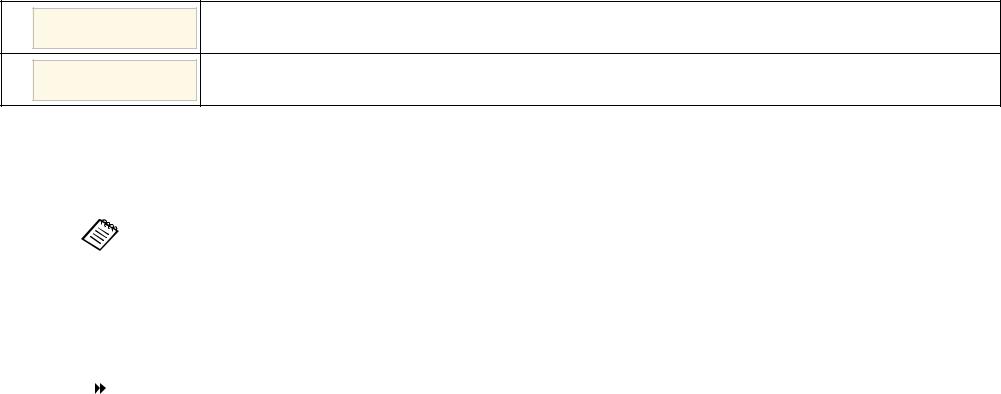
Notations Used in This Guide
Safety Symbols
The projector and its manuals use graphical symbols and labels to indicate content that tells you how to use the projector safely.
Read and carefully follow the instructions that are marked with these symbols and labels to avoid injury to persons or damage to property.
This symbol indicates information that, if ignored, could possibly result in personal injury or even death.
 Warning
Warning
This symbol indicates information that, if ignored, could possibly result in personal injury or physical damage due to incorrect handling.
 Caution
Caution
General Information Notations
|
|
|
This label indicates procedures that may result in damage or injury if sufficient care is not taken. |
|
Attention |
|
|
|
|
|
|
|
|
|
|
|
|
|
This label indicates additional information that may be useful to know. |
|
|
|
|
|
[Button name] |
|
Indicates the name of the buttons on the remote control or the control panel. |
|
|
|
Example: [Esc] button |
|
|
|
|
|
Menu/Setting name |
|
Indicates projector menu and setting names. |
|
|
|
Example: |
|
|
|
Select the Image menu |
|
|
|
s Image > Advanced |
|
|
|
|
|
|
|
This label indicates links to the related pages. |
|
|
|
|
|
s |
|
This label indicates the projector's current menu level. |
|
|
|
|
Introduction to Your Projector
Refer to these sections to learn more about your projector's features and part names. g Related Links
•"Projector Features" p.10
•"Projector Parts and Functions" p.14
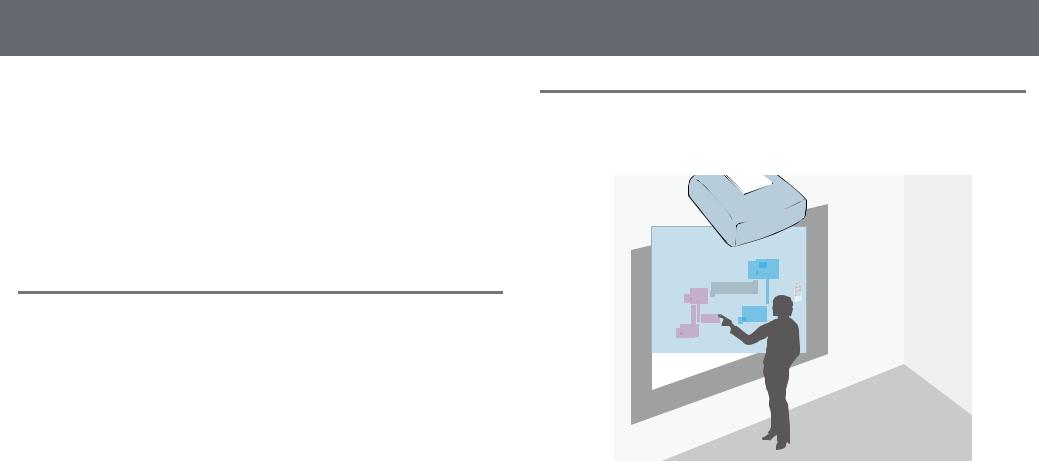
Projector Features
This projector comes with this special features. Refer to these sections for more details.
g Related Links
•"Long-life Laser Light Source" p.10
•"Unique Interactive Functions" p.10
•"Quick and Easy Setup" p.11
•"Flexible Connectivity" p.11
•"Easy Operation from the Control Pad" p.12
•"Large-scale Presentation from the Whiteboard" p.13
Long-life Laser Light Source
A solid-state laser light source provides virtually maintenance-free operation until light source brightness is reduced.
10
Unique Interactive Functions
Easy annotation on the projected screen using the interactive pen or your finger.
•Annotation with or without a computer.
•Annotation with two pens at the same time.
•Quick and easy toolbar to aid you in annotating the screen.
•Projector operations from the projected screen.
•Share your whiteboard with other devices, including tablets, smartphones, and other projectors with whiteboard sharing capabilities.
•Scan and display content from a connected scanner.
•Email, save, or print your content without a computer.
•Import content from a USB drive.
•Remote desktop connection to control a remote computer.
•Computer operations from the projected screen.
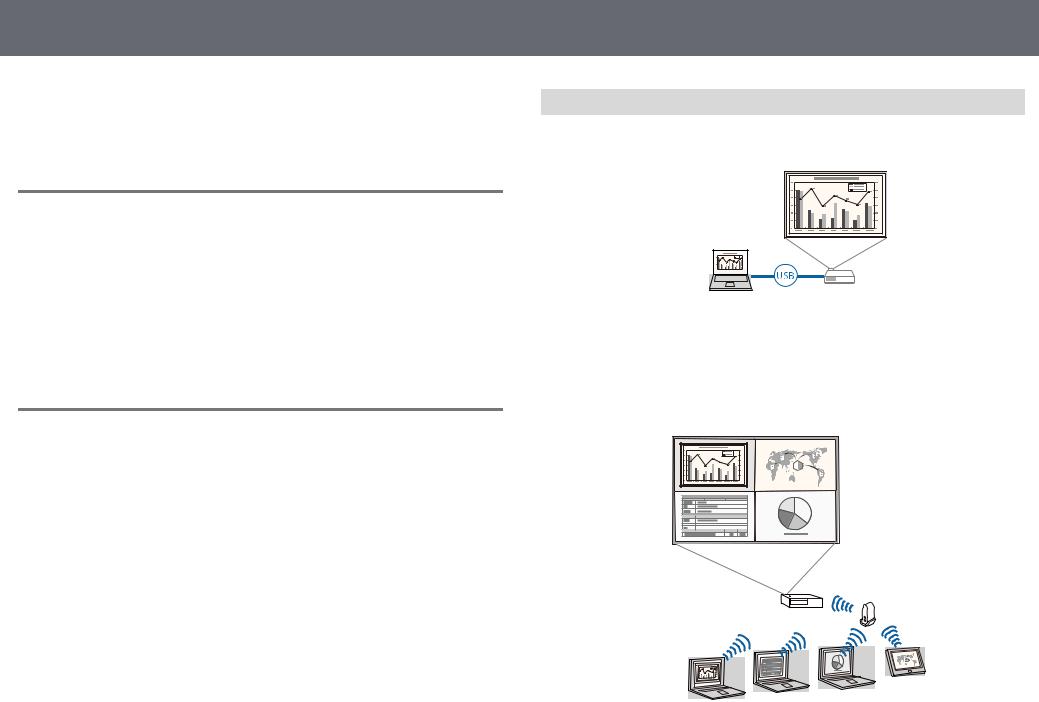
Projector Features
• Touch-based interactivity using your finger.
g Related Links
• "Using the Interactive Features" p.81
Quick and Easy Setup
•Direct Power On feature to turn on the projector as soon as you plug it in.
•Auto Power On feature to turn on the projector when the projector detects an image signal from the port you specified as the Auto Power On source.
•Home screen feature to easily select an input source and useful functions.
g Related Links
•"Turning On the Projector" p.49
•"Home Screen" p.50
Flexible Connectivity
This projector supports a wide variety of easy-to-use connectivity options as shown below.
g Related Links
•"Connect with Computers" p.11
•"Connect with Mobile Devices" p.12
11
Connect with Computers
•Connect with one USB cable to project images and output audio (USB Display).
•Epson iProjection (Windows/Mac) to project up to four images at the same time by splitting the projected screen. You can project images from computers on the network, or from smartphones or tablet devices on which Epson iProjection is installed.
See the Epson iProjection Operation Guide (Windows/Mac) for details.
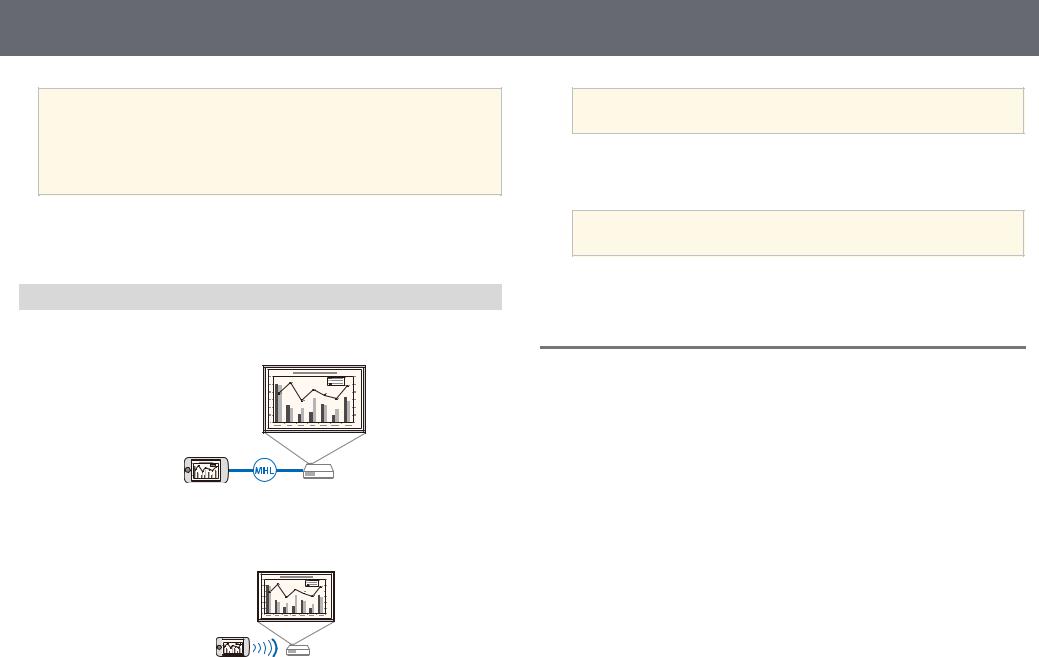
Projector Features
a• When projecting images using a wireless LAN, you must install the Epson 802.11b/g/n wireless LAN module, and then set up your projector and computer for wireless projection.
•You can download the necessary software and manuals from the following Web site:
http://www.epson.com/
g Related Links
•"Connecting to a Computer" p.30
•"Using the Projector on a Network" p.172
Connect with Mobile Devices
•HDMI1/MHL port to connect an MHL cable to the mobile device and to the projector.
•Screen Mirroring to connect your projector and mobile device wirelessly using Miracast technology.
12
aAny fees incurred when communicating with the App Store or Google Play are the responsibility of the customer.
•Epson iProjection (Chromebook) to connect your projector and Chromebook device wirelessly using the app available on the Chrome Web Store.
aAny fees incurred when communicating with the Chrome Web Store are the responsibility of the customer.
g Related Links
• "Connecting to Smartphones or Tablets" p.33
Easy Operation from the Control Pad
You can easily perform frequently used operations such as turning the power on/off and changing the source.
You can also connect various USB devices to multiple USB ports.
•Epson iProjection (iOS/Android) to connect your projector and mobile device wirelessly using the app available on the App Store or Google Play.
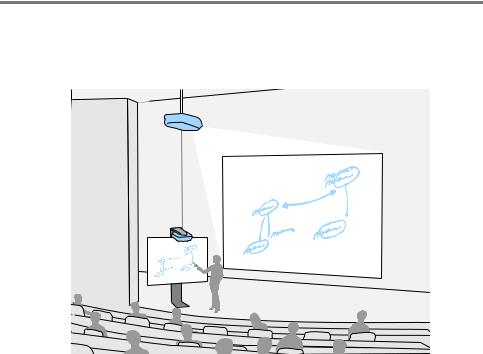
Projector Features |
13 |
|
|
Large-scale Presentation from the Whiteboard
By connecting your projector to other projectors using the DVI-D Out port, you can easily project your whiteboard image live onto a large screen.
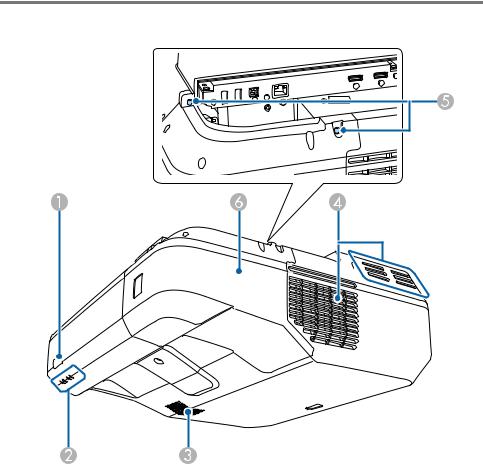
Projector Parts and Functions |
14 |
|
|
The following sections explain the projector parts and their functions. g Related Links
•"Projector Parts - Front/Side" p.14
•"Projector Parts - Top/Side" p.15
•"Projector Parts - Interface" p.16
•"Projector Parts - Base" p.18
•"Projector Parts - Control Panel" p.19
•"Projector Parts - Remote Control" p.20
•"Projector Parts - Interactive Pens" p.21
•"Projector Parts - Pen Stand" p.22
•"Projector Parts - Control Pad" p.23
•"Projector Parts - Touch Unit" p.24
Projector Parts - Front/Side
Name |
Function |
|
A |
Remote receiver |
Receives signals from the remote control. |
|
|
|
B |
Indicators |
Indicates the projector's status. |
|
|
|
C |
Speaker |
Outputs audio. |
|
|
|
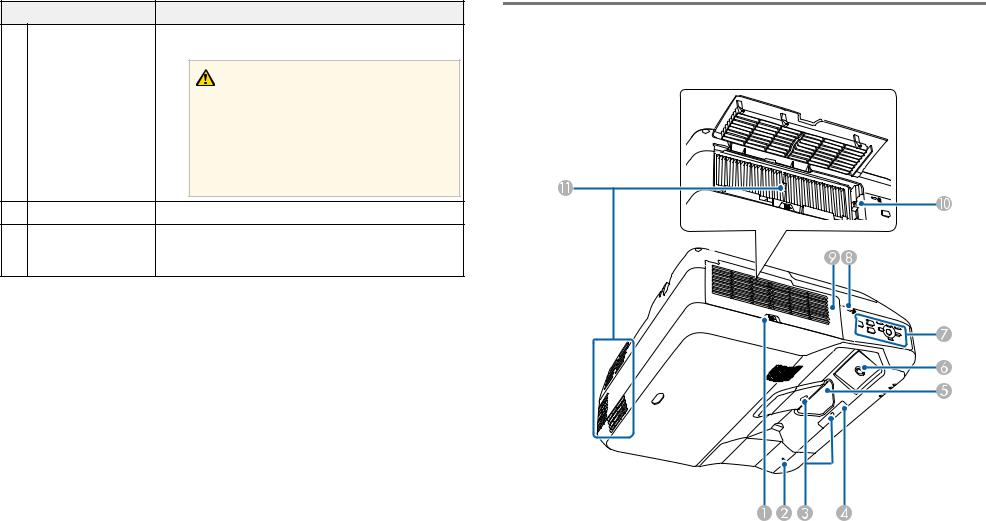
Projector Parts and Functions |
15 |
|
|
Name |
Function |
Projector Parts - Top/Side |
D Air exhaust vent |
Exhaust vent for air used to cool the projector |
|
|
internally. |
|
|
Caution |
|
|
While projecting, do not put your face or |
|
|
hands near the air exhaust vent, and do not |
|
|
place objects that may become warped or |
|
|
damaged by heat near the vent. Hot air from |
|
|
the air exhaust vent could cause burns, |
|
|
warping, or accidents to occur. |
|
E Cable cover screws |
Screws to fix the cable cover in place. |
|
F Cable cover |
Loosen the two screws and open the cover when |
|
|
connecting cables for external devices or installing the |
|
|
wireless LAN module. |
|
g Related Links
• "Projector Indicator Status" p.264
• "Remote Control Operation" p.47
Name |
Function |
|
A |
Filter cover latch |
Opens the air filter cover. |
|
|
|
B |
indicatorWireless LAN |
Indicates the access status of the wireless LAN module. |
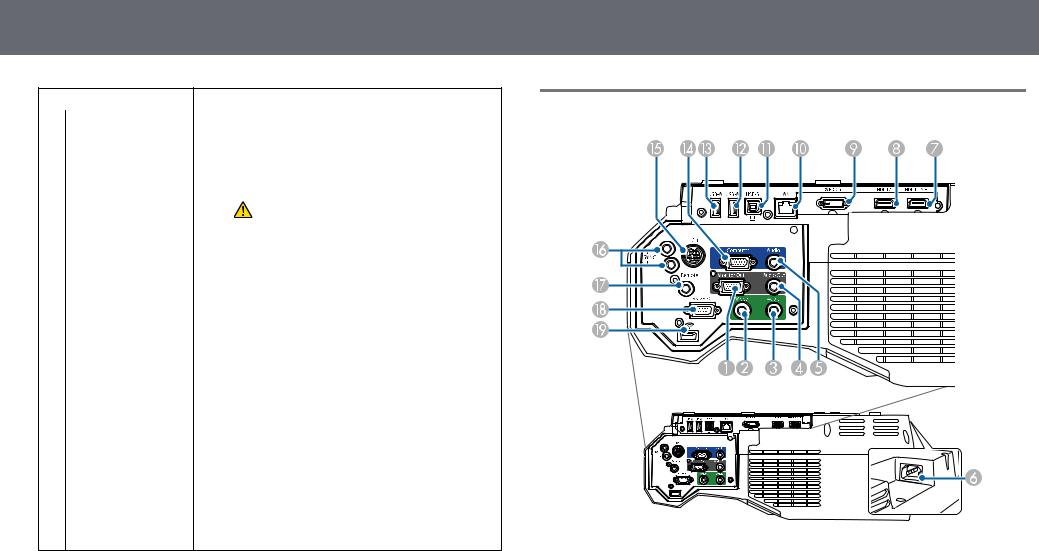
Projector Parts and Functions
Name |
Function |
C Obstacle sensor |
Detects obstacles that are interfering with the |
|
projection area. |
D Remote receiver |
Receives signals from the remote control. |
E Projection window |
Images are projected from here. |
|
|
|
Warning |
|
|
|
|
• Do not look into the projection window |
|
|
|
|
while projecting. |
|
|
|
|
• Do not place any objects or put your hand |
|
|
|
|
near the projection window. It could cause |
|
|
|
|
burns, fire, or the object to warp because this |
|
|
|
|
area reaches a high temperature due to the |
|
|
|
|
concentrated projection light. |
|
|
|
|
|
|
|
|
|
|
|
F receiverInteractive pen |
Receives signals from the interactive pen. |
|
||
G Control panel |
Operates the projector. |
|
||
H Security slot |
The security slot is compatible with the Microsaver |
|
||
|
|
Security System manufactured by Kensington. |
|
|
I Air filter cover |
Open to access the air filter or focus lever. |
|
||
J Focus lever |
Adjusts the image focus. |
|
||
|
|
Open the air filter cover to operate. |
|
|
|
|
|
|
|
K |
Air intake vent (air |
Takes in air to cool the projector internally. |
|
|
|
filter) |
|
|
|
g Related Links
•"Installing a Security Cable" p.171
•"Focusing the Image" p.56
16
Projector Parts - Interface
Name |
Function |
|
A |
Monitor Out port |
Outputs analog RGB signals input from the Computer |
|
|
port to an external monitor. You cannot output signals |
|
|
input from other ports or component video signals. |
|
|
|
B |
Video port |
Inputs composite video signals from video sources. |
|
|
|

Projector Parts and Functions
Name |
Function |
|
C |
Audio port |
Inputs audio from equipment connected to the Video |
|
|
port. |
|
|
Inputs audio from other devices when projecting |
|
|
images from the device connected to the USB-A port. |
|
|
From now on, referred to as the Audio 2 port. |
|
|
|
D |
Audio Out port |
Outputs audio from the current input source to an |
|
|
external speaker. |
E |
Audio port |
Inputs audio from equipment connected to the |
|
|
Computer port. |
|
|
From now on, referred to as the Audio 1 port. |
|
|
|
F |
Power inlet |
Connects the power cord to the projector. |
|
|
|
G |
HDMI1/MHL port |
Inputs video signals from HDMI compatible video |
|
|
equipment and computers, or MHL (Mobile High- |
|
|
Definition) compatible mobile devices. |
|
|
This port is compatible with HDCP. |
|
|
|
H |
HDMI2 port |
Inputs video signals from HDMI compatible video |
|
|
equipment and computers. |
|
|
This port is compatible with HDCP. |
|
|
|
I |
DVI-D Out port |
Outputs video signals to an external monitor. |
|
|
This port is not compatible with HDCP. |
|
|
|
J |
LAN port |
Connects a LAN cable to connect to a network. |
|
|
|
K |
USB-B port |
Connects a USB cable to the computer to project |
|
|
computer images or to use the Wireless Mouse |
|
|
function. |
|
|
Connects the projector to a computer via the supplied |
|
|
USB cable to use the interactive pen as a mouse. |
|
|
Connects a USB cable to the control pad when |
|
|
connecting a computer to the control pad. |
17
Name |
Function |
|
L |
USB-A port |
Connects a USB memory device or a digital camera |
|
|
and projects movies or images using PC Free. Select |
|
|
USB1 as the image source when you connect a USB |
|
|
device to this port to use the projector's PC Free |
|
|
features. |
|
|
Connects the optional document camera. Select USB2 |
|
|
as the image source when you connect the document |
|
|
camera to this port. |
|
|
Connects a USB cable to the control pad when |
|
|
connecting a USB storage device, printer, or USB |
|
|
keyboard to the control pad. |
M |
USB-A port |
Connects a USB memory device or a digital camera |
|
|
and projects movies or images using PC Free. Select |
|
|
USB1 as the image source when you connect a USB |
|
|
device to this port to use the projector's PC Free |
|
|
features. |
|
|
Connects the optional document camera. Select USB2 |
|
|
as the image source when you connect the document |
|
|
camera to this port. |
|
|
Connects a USB cable to the control pad when |
|
|
connecting a USB storage device, printer, or USB |
|
|
keyboard to the control pad. |
N |
Computer port |
Inputs image signals from a computer and component |
|
|
video signals from other video sources. |
O |
TCH port |
Connects the supplied Touch Unit connection cable to |
|
|
the Touch Unit. |
P |
SYNC IN/OUT ports |
When using the interactive features in the same room |
|
|
as multiple versions of the same projector, you need to |
|
|
connect the optional remote control cable set to the |
|
|
projectors. When the cable set is connected, the |
|
|
interactive pen operates stably. |
Q |
Remote port |
Connects to the control pad with the remote control |
|
|
cable set. |
R |
RS-232C port |
Connects an RS-232C cable to control the projector |
|
|
from a computer. (This port is for control use and |
|
|
should not normally be used.) |
|
|
|
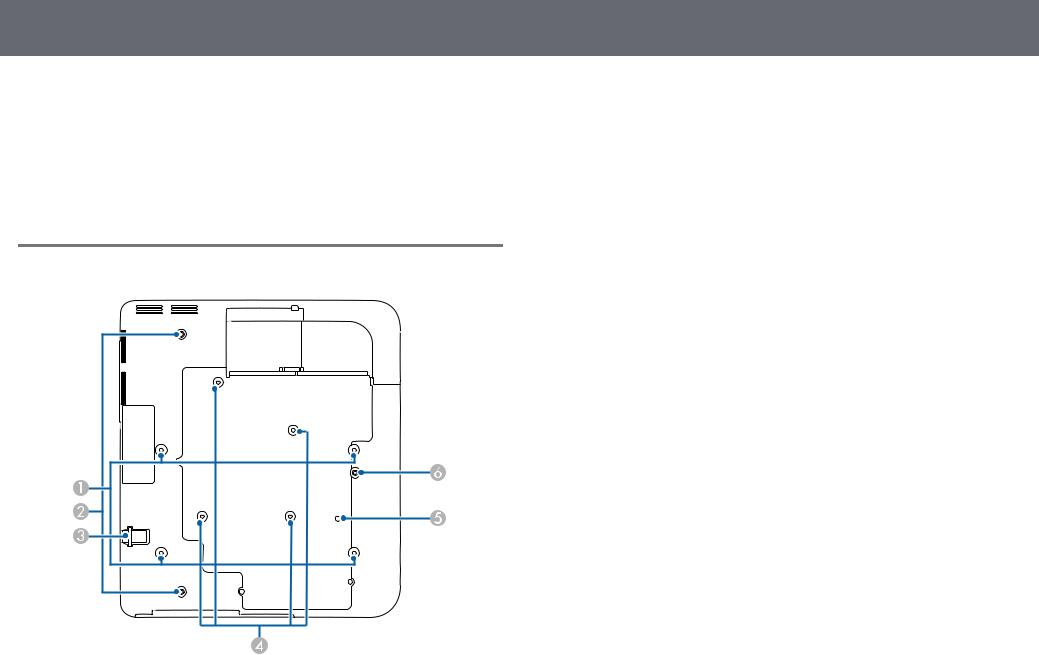
Projector Parts and Functions
Name |
Function |
|
S |
slotWireless LAN module |
Install the wireless LAN module. |
g Related Links
• "Projector Connections" p.30
Projector Parts - Base
|
|
18 |
|
|
|
Name |
Function |
|
A |
Ceiling mount fixing |
Attach the optional ceiling mount here when |
|
points (four points) |
suspending the projector from a ceiling. |
B |
Rear foot fixing |
Attach the feet when using the projector on a surface |
|
points (two points) |
such as a desk. (Only models with feet supplied) |
C |
Security cable |
Pass a commercially available wire lock through here |
|
attachment point |
and lock it in place. |
|
|
Do not pass drop-prevention wires through here when |
|
|
mounting the projector on a wall or suspending it from |
|
|
a ceiling. |
|
|
|
D |
Wall mount fixing |
Attach the supplied or optional setting plate when |
|
points (four points) |
mounting on a wall. |
E |
Illumination sensor |
Detects the brightness of the surroundings, and |
|
|
automatically adjusts the brightness of the screen. Set |
|
|
Light Source Mode to Auto in the projector's ECO |
|
|
menu. |
|
|
s ECO > Brightness Settings > Light Source Mode |
|
|
> Auto |
F |
Front foot fixing |
Attach the foot with a spacer when using the projector |
|
point |
on a surface such as a desk. (Only models with feet |
|
|
supplied) |
g Related Links
• "Installing a Security Cable" p.171
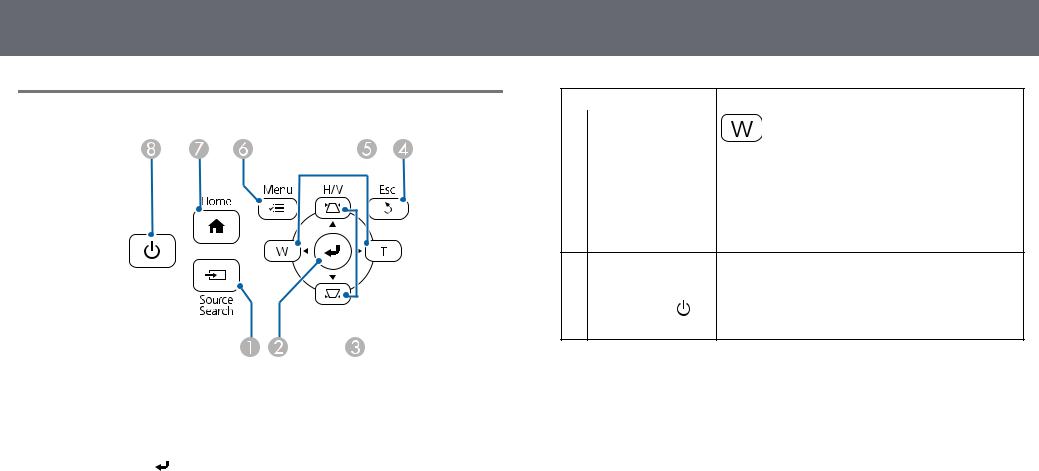
Projector Parts and Functions
Projector Parts - Control Panel
Name |
Function |
|
A |
button[Source Search] |
Changes to the next input source. |
B |
[Enter] button [ ] |
Enters the current selection and moves to the next level |
|
|
while displaying the projector's menu or help. |
|
|
Optimizes Tracking, Sync., and Position in the |
|
|
projector's Signal menu while projecting an analog |
|
|
RGB signal from the Computer port. |
|
|
From now on, referred to as the [Enter] button. |
|
|
|
C |
Keystone adjustment |
Displays the Keystone screen allowing you to correct |
|
buttons and arrow |
keystone distortion. |
|
buttons |
Selects menu items while displaying the projector's |
|
|
menu or help. |
D |
[Esc] button |
Stops the current function. |
|
|
Moves back to the previous menu level while |
|
|
displaying the projector's menu. |
19
Name |
Function |
|
E |
Wide/Tele buttons |
|
|
and arrow buttons |
: Enlarges the size of the projected image. |
 : Reduces the size of the projected image.
: Reduces the size of the projected image.
Corrects keystone distortion in the horizontal direction when the Keystone screen is displayed.
Selects menu items while displaying the projector's menu or help.
F [Menu] button |
Displays and closes the projector's menu. |
G [Home] button |
Displays and closes the Home screen. |
H Power button [ ] |
Turns the projector on or off. |
|
From now on, referred to as the power button. |
g Related Links
•"Home Screen" p.50
•"Selecting an Image Source" p.68
•"Correcting the Image Shape with the Keystone Buttons" p.59
•"Resizing the Image with the Buttons" p.66
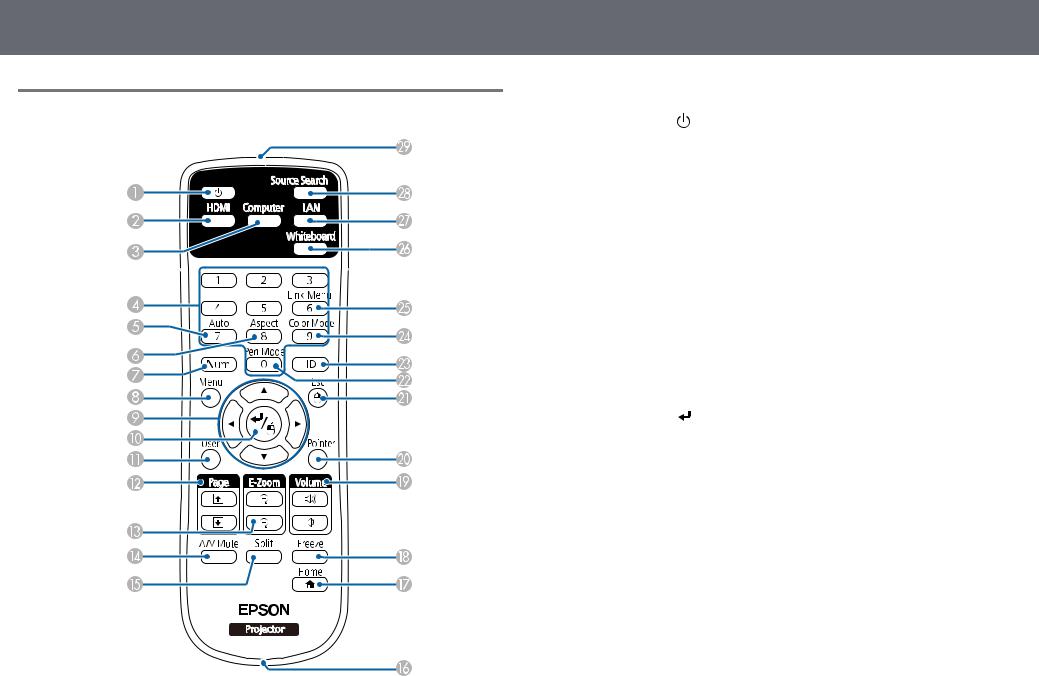
Projector Parts and Functions
Projector Parts - Remote Control
20
Name |
|
Function |
|
A |
Power button [ |
] |
Turns the projector on or off. |
|
|
|
From now on, referred to as the power button. |
|
|
|
|
B |
[HDMI] button |
|
Switches the image source between the HDMI ports. |
|
|
|
|
C |
[Computer] button |
Selects the Computer port as the image source. |
|
|
|
|
|
D |
Numeric buttons |
|
Enters numbers in the projector's menu while holding |
|
|
|
down the [Num] button. |
|
|
|
|
E |
[Auto] button |
|
Optimizes Tracking, Sync., and Position in the |
|
|
|
projector's Signal menu while projecting an analog |
|
|
|
RGB signal from the Computer port. |
|
|
|
|
F |
[Aspect] button |
|
Changes the aspect mode. |
|
|
|
|
G |
[Num] button |
|
Hold down this button to enter numbers using the |
|
|
|
numeric buttons. |
|
|
|
|
H |
[Menu] button |
|
Displays and closes the projector's menu. |
|
|
|
|
I |
Arrow buttons |
|
Selects menu items while displaying the projector's |
|
|
|
menu or help. |
|
|
|
|
J |
[Enter] button [ |
] |
Enters the current selection and moves to the next level |
|
|
|
while displaying the projector's menu or help. |
|
|
|
Acts as a mouse's left button when using the Wireless |
|
|
|
Mouse function. |
|
|
|
From now on, referred to as the [Enter] button. |
|
|
|
|
K |
[User] button |
|
Performs settings assigned in the User Button setting |
|
|
|
in the projector's Settings menu. |
L |
[Page] up/down |
|
Controls page up and down on your computer when |
|
buttons |
|
you connect a projector and computer using a USB |
|
|
|
cable or over a network. |
|
|
|
Displays the previous or next screen while using the PC |
|
|
|
Free feature. |
M |
[E-Zoom] +/– |
|
Zooms in or zooms out the image area. |
|
buttons |
|
|
N |
[A/V Mute] button |
Turns the video and audio on or off temporarily. |
|
|
|
|
|
O |
[Split] button |
|
Projects two images from different image sources |
|
|
|
simultaneously by splitting the projected screen. |
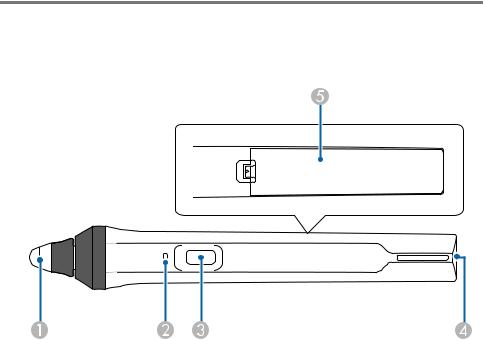
Projector Parts and Functions |
21 |
|
|
Name |
Function |
|
P |
Strap attachment |
Allows you to attach a commercially available strap to |
|
point |
the remote control. |
Q |
[Home] button |
Displays and closes the Home screen. |
|
|
|
R |
[Freeze] button |
Pauses or resumes images. |
|
|
|
S |
buttons[Volume] up/down |
Adjusts the speaker volume. |
T |
[Pointer] button |
Displays the on-screen pointer. |
|
|
|
U |
[Esc] button |
Stops the current function. |
|
|
Moves back to the previous menu level while |
|
|
displaying the projector's menu. |
|
|
Acts as a mouse's right button when using the Wireless |
|
|
Mouse function. |
|
|
|
V |
[Pen Mode] button |
Changes between operating the computer or drawing |
|
|
using the interactive pen. |
|
|
(This button cannot be used in whiteboard mode.) |
|
|
|
W |
[ID] button |
Hold down this button and press the numeric buttons |
|
|
to select the ID for the projector you want to operate |
|
|
using the remote control. |
X |
[Color Mode] button |
Changes the color mode. |
|
|
|
Y |
[Link Menu] button |
Displays the settings menu for the device linked to the |
|
|
projector's HDMI ports. |
Z |
[Whiteboard] button |
Turns the projector on (if necessary) and displays |
|
|
whiteboard mode. |
|
|
Switches to the previous input source during |
|
|
whiteboard mode. |
a |
[LAN] button |
Switches the image source between the network |
|
|
connected devices. |
b |
button[Source Search] |
Changes to the next input source. |
c |
Remote control light |
Outputs remote control signals. |
|
emitting area |
|
g Related Links
•"Image Aspect Ratio" p.70
•"Color Mode" p.72
•"Input Signal Settings - Signal Menu" p.214
•"Projector Setup Settings - Extended Menu" p.219
•"Projecting Two Images Simultaneously" p.141
•"Using the Remote Control as a Wireless Mouse" p.154
•"Using the Remote Control as a Pointer" p.156
•"Projecting a PC Free Presentation" p.144
•"Using the Projector on a Network" p.172
Projector Parts - Interactive Pens
Hold the pen to turn it on automatically. Pens turn off automatically after 15 seconds when you put them down.
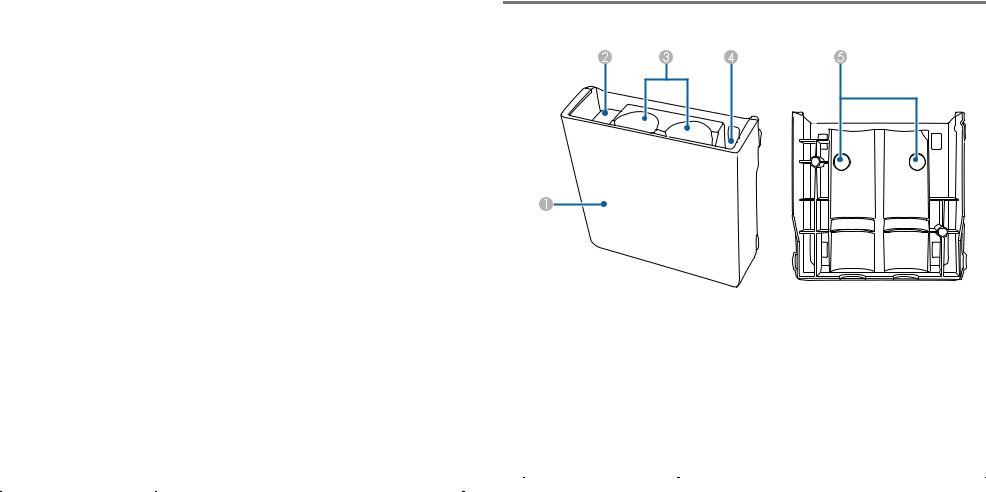
Projector Parts and Functions |
22 |
|
|
Name |
Function |
|
A |
Pen tip |
Replaceable soft pen tip. |
|
|
If the soft tip is hard to use on a textured surface, |
|
|
replace it with the hard tip. |
|
|
|
B |
Battery indicator |
Press the button on the side of the pen to indicate the |
|
|
remaining battery power. |
|
|
• When the battery is charged, the indicator turns blue |
|
|
until you release the button. |
|
|
• When the battery is running low, the indicator |
|
|
flashes blue until you release the button. |
|
|
• Does not light when the battery is exhausted. Change |
|
|
the battery. |
C |
Button |
When Pen Button Function is set to Eraser in the |
|
|
projector's Extended menu, press the button to switch |
|
|
the tip function between pen and eraser while drawing. |
|
|
When Pen Button Function is set to Open Drawing |
|
|
Toolbar, press the button to display the toolbar near |
|
|
the pen tip. |
|
|
When Pen Button Function is set to Clear Screen, |
|
|
press the button to erase all the contents drawn on the |
|
|
projected screen. |
|
|
s Extended > Easy Interactive Function > General |
|
|
> Advanced > Pen Button Function |
|
|
Press the button to perform a right-click operation |
|
|
while using the pen as a mouse. |
D |
pointStrap attachment |
Allows you to attach a commercially available strap. |
E |
Battery cover |
Open this cover when replacing the battery. |
|
|
|
g Related Links
• "Replacing the Interactive Pen Tip" p.260
Projector Parts - Pen Stand
Name |
Function |
|
A |
Front cover |
Open to install the pen stand. |
|
|
|
B |
Pen tip storage space |
Keep the pen tips here. |
|
|
|
C |
Pen storage space |
Keep the pens here. |
|
|
|
D |
Battery storage space |
Keep the AA batteries here. |
|
|
|
E |
Screw holes (for |
The screw holes for securing the pen stand. |
|
installation) |
|
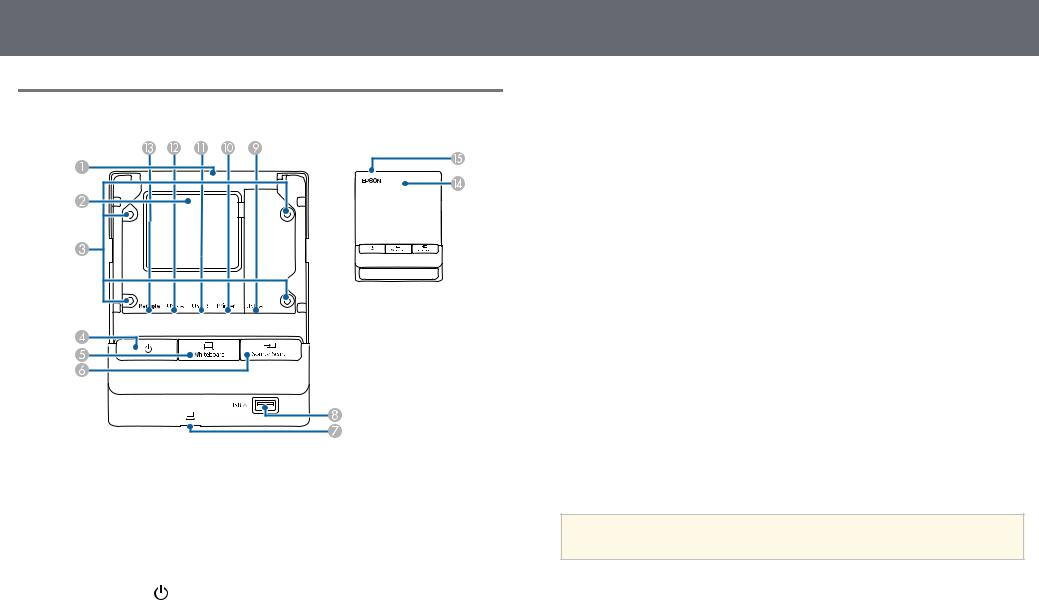
Projector Parts and Functions
Projector Parts - Control Pad
Name |
|
Function |
|
A |
Cable path (upper) |
|
Open the cover to route cables through here. |
|
|
|
|
B |
Cable path |
|
Route cables through here. |
|
|
|
|
C |
Screw holes (for |
|
The screw holes for securing the control pad. |
|
installation) |
|
|
D |
Power button [ |
] |
Turns the projector on or off. |
|
|
|
From now on, referred to as the power button. |
E |
[Whiteboard] button |
Turns the projector on (if necessary) and displays |
|
|
|
|
whiteboard mode. |
|
|
|
Switches to the previous input source during |
|
|
|
whiteboard mode. |
F |
button[Source Search] |
|
Changes to the next input source. |
23
Name |
Function |
|
G |
USB-B port (for |
Connects a USB cable to the computer to project |
|
connecting a |
computer images or to use the interactive pen as a |
|
computer) |
mouse. |
|
|
|
H |
USB-A port (for |
Connects a USB storage device. |
|
connecting USB |
|
|
storage) |
|
|
|
|
I |
USB-A port (for |
Connects an external USB keyboard. |
|
connecting a |
|
|
keyboard) |
|
|
|
|
J |
USB-A port (for |
Connects a USB cable to the printer. |
|
connecting a printer) |
|
K |
USB-B port (for |
Connects a USB cable to the projector when |
|
connecting a |
connecting a USB storage device, printer, or USB |
|
projector) |
keyboard to the control pad. |
L |
USB-A port (for |
Connects a USB cable to the projector when |
|
connecting a |
connecting a computer to the control pad. |
|
projector) |
|
M |
Remote port |
Connects to the projector with the cable supplied with |
|
|
the control pad to power the control pad. |
N |
Front cover |
Open to connect cables. |
|
|
|
O |
Cable cover |
Open this cover when cables are wired along a wall. |
|
|
|
aStick the supplied port protection stickers on the ports that are not being used.
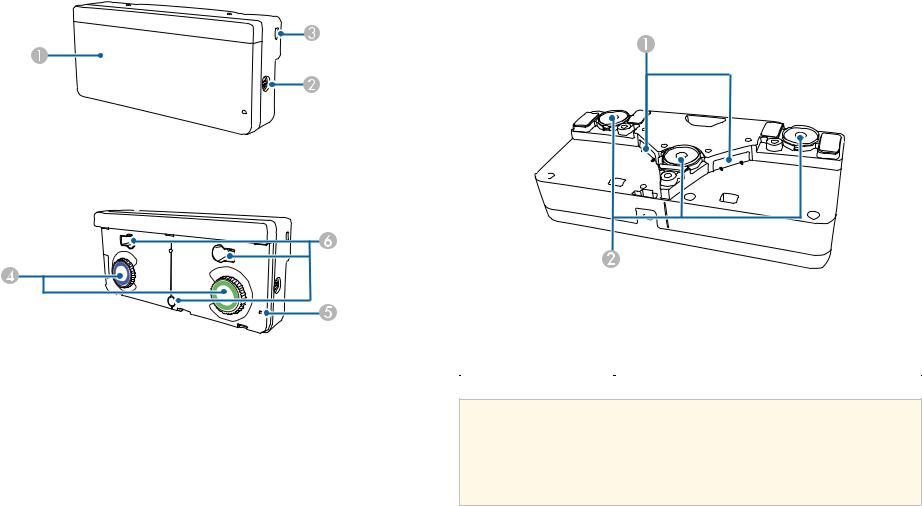
|
|
Projector Parts and Functions |
|
|
24 |
|
|
|
|
|
|
|
|
|
|
|
|
|
|
|
|
|
|
|
|
Projector Parts - Touch Unit |
|
Name |
Function |
|
|
|
|
|
|
F |
Screw holes (for |
The screw holes for securing the Touch Unit. |
|
|
|
Front |
|
installation) |
|
|
|
|
|
|
|
|
|
||
Rear
When the dial cover is not attached
Name |
Function |
|
A |
Dial cover |
Remove to use the adjustment dials. |
|
|
|
B |
TCH port |
Connects the projector to the Touch Unit with the |
|
|
Touch Unit connection cable. |
C |
Security slot |
The security slot is compatible with the Microsaver |
|
|
Security System manufactured by Kensington. |
D |
Adjustment dials |
Perform angle adjustments. |
|
|
|
E |
Indicator |
Lit when the Touch Unit is turned on. |
|
|
|
Name |
Function |
|
A |
Laser diffusion ports |
Diffuse laser light to detect the position of fingers. |
|
|
|
B |
Installation magnets |
Magnets used for installation. |
|
|
|
 Warning
Warning
Do not use the Touch Unit near medical equipment such as pace makers. Furthermore, when using the Touch Unit, make sure there is no medical equipment such as pace makers, in the surrounding area. Electromagnetic interference may cause medical equipment to malfunction.

Projector Parts and Functions |
25 |
|
|
 Caution
Caution
•Do not use the Touch Unit near magnetic storage media such as magnetic cards, or precision electronic devices such as computers, digital watches, or cell phones. Data could be corrupted or a malfunction could occur.
•When installing the Touch Unit on a magnetic surface, be careful not to trap your fingers or any other part of your body between the magnet and the installation surface.
Attention
•Do not connect the Touch Unit to any devices except for EB 1470Ui. The device could malfunction, or laser light could leak beyond the limit.
•Make sure you use the supplied Touch Unit connection cable. Operations are not possible with a commercially available cable.
•When disposing of the Touch Unit, do not disassemble it. Dispose according to your local or national laws and regulations.
aSee the Installation Guide for the Touch Unit installation methods and angle adjustment methods.
Setting Up the Projector
Follow the instructions in these sections to set up your projector. g Related Links
•"Projector Placement" p.27
•"Projector Connections" p.30
•"Installing Batteries in the Remote Control" p.45
•"Installing Batteries in the Pens" p.46
•"Remote Control Operation" p.47
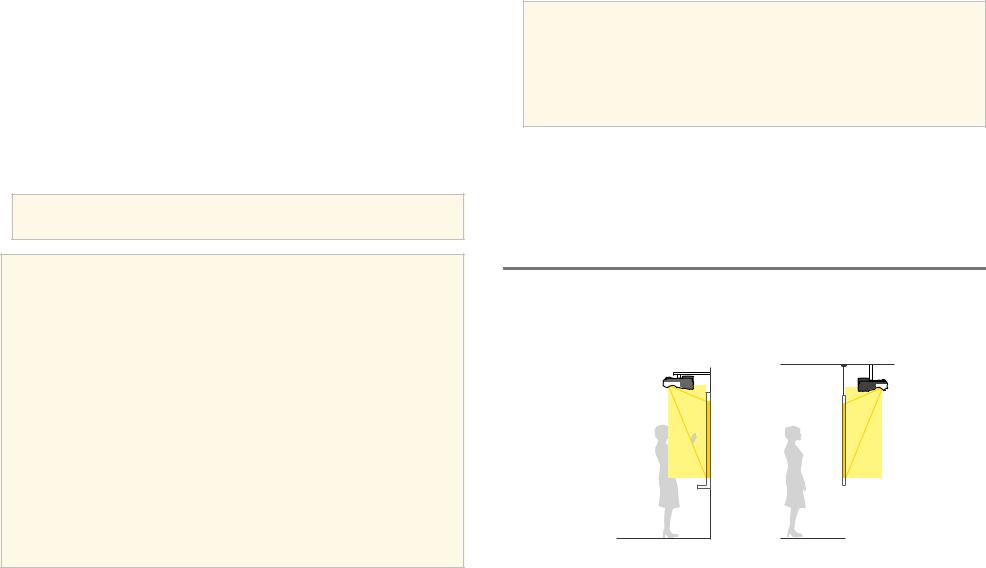
Projector Placement |
27 |
|
|
You can install the projector on a wall, or place it on a table to project images.
You need the optional mounts when suspending the projector from a ceiling, installing it on a wall, or placing it vertically on a table.
Note the following points when selecting a projector location:
•Place the projector on a sturdy, level surface or install it using a compatible mount.
•Leave plenty of space around and under the projector for ventilation, and do not place it on top of or next to anything that could block the vents.
•Place the projector parallel to the screen.
aIf you cannot install the projector parallel to the screen, correct keystone distortion using the projector controls.
 Warning
Warning
•A special method of installation is required when suspending the projector from a wall or ceiling. If you do not install the projector correctly, it could fall and cause damage or injury.
•Do not use adhesives on the wall mount plate fixing points or the ceiling mount fixing points to prevent the screws from loosening, or use lubricants, oils, or similar substances on the projector; the projector case may crack causing it to fall from its mount. This could cause serious injury to anyone under the mount and could damage the projector.
•Do not cover the projector's air intake or air exhaust vents. If the vents are covered, the internal temperature could rise and cause a fire.
•Do not install the projector on an unstable surface or in a location beyond the weight specifications of the projector. Otherwise, it could fall or topple causing an accident and injury.
•When installing the projector in a high position, take measures to prevent falling by using wires to ensure safety in an emergency, such as an earthquake, and to prevent accidents. If it is not installed correctly, it could fall causing an accident and injury.
Attention
•If you are using the projector at altitudes above 1500 m, set the High Altitude Mode setting to On in the projector's Extended menu to ensure the projector's internal temperature is regulated properly.
s Extended > Operation > High Altitude Mode
•Try not to setup the projector in locations subject to high humidity and dust, or in locations subject to smoke from fires or tobacco smoke.
g Related Links
•"Projector Setup and Installation Options" p.27
•"Settings when Using the Interactive Features" p.28
•"Optional Accessories and Replacement Parts" p.283
•"Projector Setup Settings - Extended Menu" p.219
Projector Setup and Installation Options
You can set up or install your projector in the following ways: Front Upside Down/Rear Upside Down

Projector Placement
Front Upside Down/Rear Upside Down (Vertically)
Make sure you select the correct Projection option in the projector's Extended menu according to the installation method being used.
a• The default Projection setting is Front/Upside Down.
•You can change the Projection setting as follows by pressing down the [A/V Mute] button on the remote control for about five seconds.
•Switch Front to/from Front/Upside Down
•Switch Rear to/from Rear/Upside Down
Settings when Using the Interactive Features
When using the interactive features, project from in front of the screen. Set Projection to Front/Upside Down or Front.
28
Attention
The interactive features are operated using infrared communication. Note the following points when installing the projector.
•Do not install the projector tilted at an angle of 3˚ or more. The interactive features may not operate correctly.
•Make sure there is no strong light or sunlight shining on the interactive pen receiver, the projection screen, the projector itself, or the rear of the projector.
•Do not install the projector where it could be subjected to direct sunlight through a window. This could cause the interactive features to malfunction.
•Install the projector so that the interactive pen receiver is not too close to fluorescent lights. If the surrounding area is too bright, the interactive features may not operate correctly.
•If there is any dust stuck to the interactive pen receiver, it could interfere with infrared communication and the interactive features may not operate correctly. Clean the receiver if it is dirty.
•Do not put paint or any stickers on the cover of the interactive pen receiver.
•When using the interactive features, do not use an infrared remote control or microphone in the same room. The interactive pen could malfunction.
•Do not use devices that generate powerful noise, such as rotary devices or transformers, near the projector, as the interactive features may not operate correctly.
a• We recommend using a smooth, board type screen without any unevenness. If the projection screen is uneven, there may be distortions in the projected image.
•Distortions may occur in the projected image depending on the material of the screen and the installation method.
•When using the interactive features, install the projector so that the projected screen is a rectangle without any distortion.
•When using the interactive features in the same room as multiple projectors, interactive pen operations may become unstable. In this case, connect the optional remote control cable set to the projectors, and change Sync of Projectors to Wired from the projector's
Extended menu.
s Extended > Easy Interactive Function > General > Advanced >
Sync of Projectors

Projector Placement |
29 |
|
|
g Related Links
• "Settings when Using the Touch Unit" p.29
Settings when Using the Touch Unit
When using the Touch Unit, install the projector using one of the following methods. The Touch Unit cannot be used if another installation method is used.
•Mount the projector on a wall or suspend it from a ceiling and project images from in front of the screen (the setting plate or ceiling mount is required).
•Install vertically on a desk and project from the front of the desk (the interactive table mount is required).
g Related Links
• "Optional Accessories and Replacement Parts" p.283

Projector Connections |
30 |
|
|
You can connect the projector to a variety of computer, video, and audio sources to display presentations, movies, or other images, with or without sound.
Attention
Check the shape and orientation of the connectors on any cable you plan to connect. Do not force a connector into a port if it does not fit. The device or your projector could be damaged or could malfunction.
aSee the Quick Start Guide for a list of cables supplied with your projector. Purchase optional or commercially available cables when necessary.
•Connect a computer that has a USB port, standard video output (monitor) port, or HDMI port.
•For video projection, connect devices such as DVD players, gaming consoles, digital cameras, and smartphones with compatible video output ports.
•If your presentation or video includes sound, you can connect audio input cables.
•For slide shows or presentations without a computer, you can connect USB devices (such as a flash drive or camera) or the optional Epson document camera.
g Related Links
•"Connecting to a Computer" p.30
•"Connecting to Smartphones or Tablets" p.33
•"Connecting to Video Sources" p.34
•"Connecting to External USB Devices" p.37
•"Connecting a Printer to the Control Pad" p.39
•"Connecting to a Document Camera" p.39
•"Connecting an External USB Keyboard to the Control Pad" p.39
•"Connecting to External Output Devices" p.40
•"Connecting Multiple Projectors of the Same Model" p.42
•"Optional Accessories and Replacement Parts" p.283
Connecting to a Computer
Follow the instructions in these sections to connect a computer to the projector.
g Related Links
•"Connecting to a Computer for VGA Video and Audio" p.30
•"Connecting to a Computer for USB Video and Audio" p.31
•"Connecting to a Computer for HDMI Video and Audio" p.32
•"Connecting a Computer to the Control Pad" p.33
Connecting to a Computer for VGA Video and Audio
You can connect the projector to your computer using a VGA computer cable.
You can play sound through the projector's speaker system by connecting a commercially available 3.5 mm stereo mini-jack audio cable.
a• To connect a computer that does not have a VGA video port, you need an adapter that allows you to connect to the projector's VGA video port.
•You can also set the port used for audio input from the projector's menu.
s Extended > A/V Settings > Audio Output
•Make sure the audio cable is labeled "No resistance".
a Connect the VGA computer cable to your computer's monitor port.
